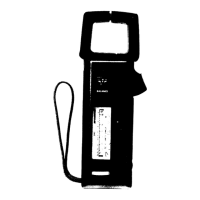I
MEASURING RESISTANCE
(Ohm
scale is
printed
in black)
INSFRT
{Jill\{PR{irJl.
l}i'iai lN51'R.1,1!,!1,.N'l:
{}Nl.
y
1il.lf
li \It.ASURINC
ItLStSi:1.NC!
l. liltrORl:. l\{AKING I{ilsISTAl\CL
il{}lASURF.lvll-.Nl.S, BI:
Sl,rRL. l HA'I
'f
Ht
ClRCL,l I
I,Nill--R
TIIST
IS
"DFIAD""'THAT
tS.'iiltrRE IS N0
vOl.'f;\GI
C(;NNLtCfL-D.
IN
CASL, OF ACCIDLNTAL
CONTA(l'I
OIj
'l-FiL
DtilvtPR{J}l[.
T{) \
"LIVE"
CIRCUIT ACCtiRATt', MI'IASUREMENTS
CANNOI IJE
\iADI1.
ALTTIOt'(li{
lllt
FtrSE
CON'IAINED lir- TIIE,
OI{I\{PROBI'. WILL PROTITCT TIIE
INSTRU\1[.N1'
F8.OM
BURNOtIT.
2.
Insert
one of
the
voltage
test leads into
the "V. Q
" receptacle
located on the
bottom
of
the instrument,
push
firmly
in and turn clockwise
to
lock
(Fig.
16). Insert the
ohmprobe
into the
"
Q
" receptacle on
the
right
side
of the instrument,
push
ilrmly
in and turn
clockwisc to lock
(Fig.
17).
F
ig.- 16
Maks
sure that the
pointer
is
on
the
"
€
"
mark of thc scale.
lf not, set the
pointer
to
the
"
@
",
using the zcro adjust screw
(Fig.
5).
When
making this adjustment,
do not short
the test leads
(l.ig.
1
8).
F is.-
17
-
o
cc
ul
N
F is.- 18
(8)

